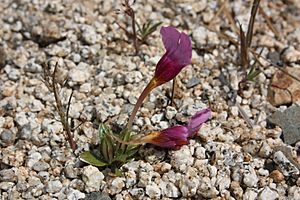Brownies facts for kids
Quick facts for kids Brownies |
|
|---|---|
 |
|
| Scientific classification | |
| Genus: |
Diplacus
|
| Species: |
douglasii
|
Diplacus douglasii is a special kind of monkeyflower. People often call it brownies or purple mouse ears. This plant grows naturally in the mountains and hills of California and Oregon. You can often find it in tough soils called serpentine soils. Famous botanists like George Bentham and Asa Gray were among the first to describe this unique plant.
Contents
What Does Purple Mouse Ears Look Like?
The Diplacus douglasii plant is very tiny. It's an annual herb, meaning it lives for only one growing season. It usually grows to be only 0.3 to 4 centimeters tall. That's less than two inches!
Its flowers are a bright magenta color. Like other monkeyflowers, they have both male and female parts. They are also "bilaterally symmetrical," which means you could cut them in half and both sides would look the same, like a butterfly. The petals are joined together, forming a tube shape. Inside this tube, you can see cool gold and purple stripes.
The top parts of the flower are magenta. The bottom parts are so small they almost look missing. Some flowers stay closed and pollinate themselves. This is called "cleistogamous." Other flowers open up. The flower sits on a tiny stem, about 2 to 4 millimeters long. The green, hairy outer part of the flower, called the calyx, is 8 to 14 millimeters long.
The leaves are shaped like an oval or a wider oval. They are 5 to 28 millimeters long. The top side of the leaves is shiny green and usually has tiny hairs. The seeds are hard and shaped a bit like an egg. They are 2.5 to 6.5 millimeters long.
Where Does It Grow?
Diplacus douglasii grows in California and Oregon. You can find it in mountains and foothills. It lives at elevations between 45 and 1200 meters. This plant is found in the Cascade and Sierra Nevada mountain ranges. It also grows in parts of Southwestern Oregon and Central Western California.
This plant is often found in serpentine soils. These soils are special because they are tough for most plants to grow in. They don't have many important nutrients. But D. douglasii can also grow in bare clay or granite soils. It often grows near small creeks. It's known as a "facultative wetland species." This means it can grow in both wet and dry places. You might also see it in chaparral and foothill woodland areas.
How Does It Live?
Diplacus douglasii flowers between February and April.
Growing in serpentine soils means this plant has special ways to survive. These soils are low in important plant nutrients like nitrogen, calcium, and phosphorus. They also have high levels of metals like nickel and chromium. These metals are harmful to most plants. But Diplacus douglasii has adapted to these difficult conditions.
Here are some other plants that often grow near Diplacus douglasii:
- Creek clematis (Clematis ligusticifolia)
- Bigleaf maple (Acer macrophyllum)
- Yellow monkey flower (Mimulus guttatus)
- Narrowleaf willow (Salix exigua)
- California wild rose (Rosa californica)
- Alkali rye (Leymus triticoides)
- California mugwort (Artemisia douglasiana)
- White alder (Alnus rhombifolia)
- California bay (Umbellularia californica)
- Red fescue (Festuca rubra)
- California blackberry (Rubus ursinus)
- Black cottonwood (Populus balsamifera ssp. trichocarpa)
- California box elder (Acer negundo var. californicum)
- Columbine (Aquilegia formosa)
Why Do Scientists Study It?
Scientists love to study monkeyflowers. They are great for understanding how living things change over time. This is because monkeyflowers come in many different shapes and sizes. They also reproduce in different ways, from self-pollinating to cross-pollinating. Plus, they are easy to study in experiments.
Researchers have even mapped out the full genetic code (genome) for Erythranthe douglasii. This helps them learn more about the plant.
Because Diplacus douglasii grows well in serpentine soils, it's a good plant to study. Scientists want to understand how plants adapt to very tough environments. They have found that different groups of D. douglasii plants react differently to their surroundings. For example, some groups produce more closed flowers (cleistogamous) when conditions are hot and dry. This helps them save resources and survive. Learning about these adaptations can help scientists understand how plants might deal with a changing climate.
See also
 In Spanish: Brownie (desambiguación) para niños
In Spanish: Brownie (desambiguación) para niños


